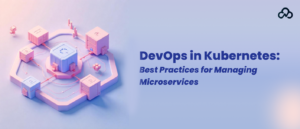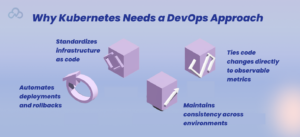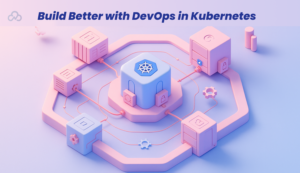DevOps in Kubernetes: Best Practices for Managing Microservices

There’s no denying it, Kubernetes has become the go-to standard for running microservices. But managing those services without the right tooling or processes? That’s where things get messy. This is exactly why teams are leaning on DevOps now more than ever. A well-integrated DevOps platform isn’t just helpful, it’s essential. It bridges the gap between automation and orchestration. It allows developers and ops teams to push updates faster, debug problems earlier, and roll back with confidence.
And as companies scale, most turn to either internal DevOps services or bring in outside cloud DevOps consulting services to tighten things up. Why? Because microservices introduce complexity, and Kubernetes alone won’t save you from it.
Why Kubernetes Needs a DevOps Approach
Kubernetes is brilliant at managing containers. But it doesn’t manage your software delivery lifecycle. That’s your job, and it’s where DevOps comes in.
Think about it. You’ve got dozens of services, each owned by different teams, deploying at different cadences. Without proper CI/CD, version control, or monitoring, it’s a house of cards.

Here’s where a DevOps platform becomes non-negotiable:
-
Automates deployments and rollbacks
-
Standardizes infrastructure as code
-
Ties code changes directly to observable metrics
-
Maintains consistency across environments
If your platform doesn’t support these needs, you’re stuck reacting to failures rather than preventing them.
CNCF’s 2023 report found that over 75% of Kubernetes users have either adopted or plan to adopt a DevOps approach in the next 12 months.
Best Practices for DevOps in Kubernetes
Let’s break it down. These are the practices successful teams rely on every day:
1. GitOps: Version Control for Your Infrastructure
With GitOps, everything, configs, secrets, deployments, is stored in Git. You don’t touch your clusters directly. Tools like ArgoCD and Flux handle the syncing.
Why it works:
-
You can roll back anything with a Git revert.
-
Access is managed via Git permissions.
-
Changes are auditable and traceable.
If you’re working with cloud DevOps services, GitOps is likely one of the first things they’ll help you set up.
2. CI/CD Pipelines Built for Kubernetes
A generic pipeline won’t cut it. You need a CI/CD flow built to work with Kubernetes-native tools like Helm, Kustomize, and container image scanning.
What you want:
-
Parallel builds for microservices
-
Canary or blue-green deployments
-
Automatic Helm chart validation
DevOps cloud services usually offer pre-built modules for all this, especially useful if you’re just getting started or scaling quickly.
3. Monitoring, Logging, and Tracing, Together
In a microservices world, you need to know when (and where) things go wrong.
- Use Prometheus and Grafana for metrics
- Use Fluent Bit or Loki for logging
- Add Jaeger for distributed tracing
When you integrate all this into your DevOps platform, you get the full picture. Not just “something broke,” but “this service caused the spike and here’s why.”
4. Security as Code
Misconfigurations are the leading cause of breaches in cloud-native apps. You can’t rely on manual checks.
Best practices:
-
Use Kyverno or OPA to enforce policies
-
Scan images before deployment
-
Lock down roles with Kubernetes RBAC
A lot of cloud DevOps consulting services now bundle DevSecOps audits into their standard engagements.
The Role of a DevOps Platform
So what should your DevOps platform actually do?
At minimum:
-
Connect code to container to deployment
-
Standardize environments across dev, staging, and prod
-
Provide audit trails and approval gates
The best platforms go further, offering integrations with cloud providers, load balancers, secrets management, and more.
DevOps cloud services often layer on monitoring, cost control, and policy enforcement, all through a single interface.
Why Cloud DevOps Consulting Services Are a Smart Move
Let’s face it, building all this in-house isn’t always realistic. Even large orgs call in reinforcements.
Here’s what top cloud DevOps consulting services bring to the table:
-
Deep experience designing cloud-native CI/CD pipelines
-
Playbooks for secure multi-cluster deployments
-
Troubleshooting frameworks that save weeks of trial and error
One fintech company cut their Kubernetes deployment time by 38% after a 6-week engagement with a DevOps consulting firm.
Whether you’re modernizing or scaling fast, outside help can be the difference between clean rollouts and firefighting.
Technical FAQs
Q1: What’s the difference between a DevOps platform and DevOps services?
A DevOps platform is a suite of integrated tools, think CI/CD pipelines, infrastructure automation, observability dashboards, and policy enforcement, that helps teams manage software delivery. You either build one internally or use something off the shelf like GitLab, Harness, or a custom Kubernetes-native stack.
DevOps services, on the other hand, refer to the people, expertise, and processes, whether internal engineers or external consultants, that design, maintain, and optimize your DevOps workflows. You need both: the platform gives you power, and the services ensure you use it wisely.
Q2: Do I need GitOps if I already use Helm?
Absolutely. Helm is great for templating and packaging Kubernetes manifests, but it doesn’t manage state. That’s where GitOps steps in, it makes Git your source of truth and ensures the cluster always reflects what’s in your repo.
With GitOps, you get:
-
Automatic rollback on failure
-
Audit trails for every change
-
Clear separation of intent vs. reality
Even cloud DevOps consulting services recommend pairing Helm with GitOps tools like ArgoCD or Flux to keep environments consistent and deployments safe.
Q3: What tools do cloud DevOps services typically use?
Top cloud DevOps services use a curated stack to streamline microservices deployment in Kubernetes. The essentials:
-
CI/CD: Jenkins X, GitHub Actions, GitLab, Tekton
-
GitOps: ArgoCD, Flux
-
IaC: Terraform, Pulumi
-
Security & Policy: Kyverno, OPA Gatekeeper
-
Monitoring: Prometheus, Grafana, Loki, Jaeger
-
Secrets Management: HashiCorp Vault, Sealed Secrets
This toolchain varies by use case, but if you’re building a modern DevOps platform, expect to touch many of these.
Q4: How do I measure success in Kubernetes-based DevOps?
Don’t just track uptime, track outcomes.
The four key DORA metrics every DevOps platform should help you measure are:
-
Deployment frequency – How often do you ship code?
-
Lead time for changes – How long does it take from commit to production?
-
Change failure rate – How often do releases cause incidents?
-
Mean time to recovery (MTTR) – How fast can you fix a broken deployment?
Cloud DevOps services often start engagements by benchmarking these KPIs, then iterating toward improvement.
Common Mistakes (and How to Avoid Them)
Even mature teams fall into patterns that slow things down, or worse, create risk. Here are a few trouble spots that often emerge in Kubernetes-based DevOps setups:
-
Building bespoke CI/CD pipelines per team → creates inconsistency, poor maintainability
-
Ignoring cluster-wide security → leaves gaps for misconfigurations and privilege escalations
-
Forgetting secrets rotation → exposes sensitive data long after it’s needed
-
No standard logging structure → makes troubleshooting slower than it should be
The fix? Set global policies through your DevOps platform, lean on best practices, and don’t reinvent the wheel. If needed, bring in cloud DevOps consulting services to conduct audits and standardize tooling before things spiral out of control.
Trends to Watch
The world of Kubernetes and DevOps evolves fast. Here’s what you’ll likely be seeing (or adopting) soon:
-
Platform engineering is rising, teams are building internal self-service portals that abstract away infrastructure details but still use the power of a shared DevOps platform underneath.
-
AI/ML for DevOps, from anomaly detection in logs to auto-scaling based on predictive load modeling, smarter automation is coming fast.
-
GitOps at enterprise scale, we’re moving toward full declarative environments across hundreds of services and clusters.
According to Gartner, by 2026, 70% of enterprises using Kubernetes will fully adopt CI/CD automation and GitOps workflows as standard practice.
If your current stack, especially your DevOps cloud services setup, doesn’t support this evolution, you’ll likely face friction as teams try to scale.
Build Better with DevOps in Kubernetes

Kubernetes isn’t just about containers. It’s about orchestrating everything, from deployments to security to monitoring, in a dynamic, fast-moving ecosystem. And without DevOps, it’s easy to get lost in the noise.
To succeed, you need a DevOps platform that brings structure, automation, and visibility to your workflows. That means CI/CD pipelines that are Kubernetes-native. Policy enforcement baked into every step. Monitoring that ties alerts to commits. And automation that helps your team move faster without losing control.
Whether you build it in-house or rely on cloud DevOps consulting services, the goal is the same: ship faster, recover quicker, and scale with confidence. The future of microservices isn’t just cloud-native, it’s DevOps-native.
Because in the world of Kubernetes, doing it manually is no longer an option.
Do you like to read more educational content? Read our blogs at Cloudastra Technologies or contact us for business enquiry at Cloudastra Contact Us